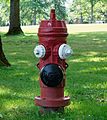Fire hydrant facts for kids
A fire hydrant is a special tool that helps firefighters put out fires. You might also hear it called a fire plug or johnny pump. These bright objects are usually easy to spot on streets, connected to the water system underground. The very first fire hydrant was recorded in Philadelphia.
Contents
How Fire Hydrants Work
When firefighters need water, they attach a hose to the fire hydrant. Then, they open a special valve on the hydrant. This lets out a strong flow of water. The water pressure is usually around 350 kilopascals (which is about 50 pounds per square inch).
The water pressure can change depending on where the hydrant is and how big the main water pipe is. Firefighters can connect the hose to a fire engine. The engine has a strong pump that can make the water pressure even higher. It can also split the water into many streams for different hoses.
Hoses can connect to hydrants in a few ways. Some use a threaded connection, while others use a quick-connect system called a Storz connector. It is very important not to open or close a fire hydrant too fast. Doing so can cause a "water hammer" effect. This can damage nearby pipes and other equipment.
When a hose is full of water, it becomes very heavy. The high water pressure also makes it stiff and hard to bend sharply. If a fire hydrant is clear of obstacles, firefighters have enough room to position the hose correctly.
Most fire hydrant valves are made to be either fully open or fully closed. They are not designed to control the water flow by being partly open. If a hydrant is only partly open, water can leak into the soil around it. Over time, this can cause serious damage to the ground.
Sometimes, special valves are added directly to the hydrant's openings. These valves help control the water flow for each hose. They also allow firefighters to change equipment without turning off the water to other hoses. It's a good idea to put these valves on all openings before using a hydrant. This is because the protective caps can sometimes fail and cause injuries.
Safety When Using Hydrants
When a firefighter uses a hydrant, they always wear special safety gear. This includes gloves and a helmet with a face shield. This gear protects them from high-pressure water. An old or damaged hydrant could fail under pressure. This could injure the firefighter or anyone nearby.
Parking Near Hydrants
In most places, it is against the law to park a car too close to a fire hydrant. In North America, you usually cannot park within 3 to 5 meters (10 to 15 feet) of a hydrant. Often, the curb nearby will be painted yellow or red to show this rule.
These rules are in place for a very important reason. Fire hydrants must be easy to see and reach during an emergency. Firefighters need quick access to them to put out fires safely and quickly.
Images for kids
-
Children playing in the spray of a fire hydrant in Philadelphia (1996)
-
Hydrant sign in Cork, Ireland, dated 1858. The letters "FC" indicate the old name for a hydrant: firecock.
-
Underground hydrant in Russia, marked with a plate and a red cone
-
A fire hydrant flushing water through a diffuser in Durham, North Carolina
-
A dry hydrant by Passumpsic River in rural Vermont
-
Hydrant at Fredantori square in Helsinki, Finland
See also
 In Spanish: Hidrante de incendio para niños
In Spanish: Hidrante de incendio para niños





































